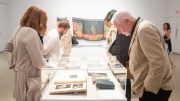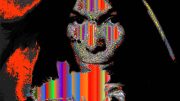You’ve seen the iconic yellow jumpsuit that Bruce Lee made famous in the ’70s, you’ve heard the familiar scream Bruce Lee unleashes just before dispatching a foe. But have you ever felt what it was like to conduct a Bruce Lee fight as if you were some sort of dance pad combat maestro?
Bruce-O-Rama, as the aceartinc. gallery describes it, is an audiovisual interactive installation that invites the participant to engage with appropriated Bruce Lee fight footage.
Imagine, then, entering a dark hall at the end of which you see a series of sensored pads on the floor. The pads are only slightly elevated above the floor; when you step on them each one individually triggers a different clip from one common Bruce Lee fight sequence. The clips are all projected on a giant screen in front of you, as if you’re playing a giant video game that allows you to remix fights from kung fu films. Myself, I couldn’t help but be reminded of the scene from the movie Big with the giant floor piano.
The more you play around with your own sequence of footsteps on the pads the more varied both the projections and their corresponding sound clips become. And as engaging as the experience as a whole can be, it is the sound of it all in particular that Bruce-O-Rama artist Claire Hodge is most interested in.
A flamenco musician herself, Hodge finds there is a certain musical quality to the fluidity and the kinetic dance of the kung fu genre of film.
“The sound score of fight scenes tend to reflect the frenetic visuals — rapid movement of the actors, quick cuts, changing angles — and become quite percussive as a result,” says Hodge. “The sounds are typically loud and short lasting — short attack, short release — akin to the sounds of a percussion instrument. As a result, they lend themselves well to reinterpretations that use alternative rhythmic structures such as flamenco music.”
For a slightly more streamlined, less interactive experience, the Bruce-O-Rama installation also offers Flamenco Bruce, a sharp re-cutting of several Bruce Lee fight clips edited in such a way that the sound effects of the combat, in quick succession, mimic the sounds of a flamenco dance.
When it came down to actually pulling from her resources, Hodge says she took in any and all Bruce Lee films she could get her hands on.
“If you look closely at Flamenco Bruce, you should see at least five different sources. As for the interactive piece, my choices were mostly limited in that I had to find Bruce Lee films that had fight scenes that could be re-spatialized to create a wider cinematic space. Trust me, no easy task. So I was initially looking more at the visual aspect.”
And although the odd comparison will be made here and there, Hodge laughs at the notion that her foot sensor design was at all inspired by the popular Dance Dance Revolution video game series.
“Funny enough, I did not know about [that game] when I first came up with the idea of the floor sensors,” says Hodge.
“I initially had thought of using a punching bag as an interactive structure, where people would hit the bag and trigger video events. I was clear from the start that I wanted the interactive framework to promote physical engagement. However, I later also became interested in the idea of filmic and spectatorial/mental space and wanted to create an interactive system that made people aware of the space, the positioning of their bodies in the space, etc.. I think that’s where the floor sensors basically came in.”
The Bruce-O-Rama exhibit launched Sept. 1 and will run until Oct. 1 at the aceartinc. gallery, second floor, 290 McDermot Avenue.




